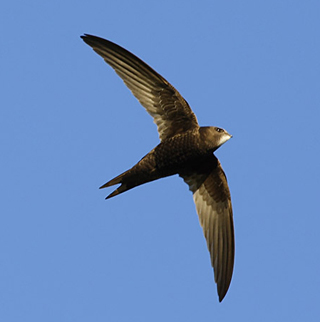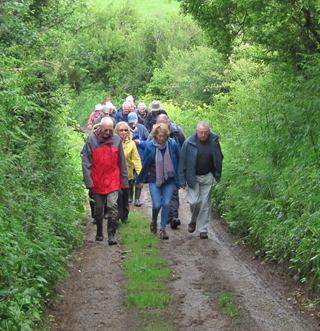In 2001 we started work to bring our cottage into the 21st century. Little did we know that “guests” would move in before we’d finished!
 Our slow DIY build resulted in soffits not being the highest priority, and one May day, we saw a large swallow-like bird swoop up under the eaves and back out. Then again, then two, in, out, bigger, faster, not swallows. Research indicated that these might be swifts; and the dusk high speed chasing, swooping and screaming confirmed it. At 69mph they are our fastest bird in level flight!
Our slow DIY build resulted in soffits not being the highest priority, and one May day, we saw a large swallow-like bird swoop up under the eaves and back out. Then again, then two, in, out, bigger, faster, not swallows. Research indicated that these might be swifts; and the dusk high speed chasing, swooping and screaming confirmed it. At 69mph they are our fastest bird in level flight!
Swifts are a very old species. A fossilized swift found in oil shales in Hesse, Germany, flew and hunted for insects over what was shallow sea and marshland 49 million years ago. Our common swift is a direct descendant and, although larger with a 40 cm wingspan, looks just like the fossil…
 Swifts are in trouble and declining. They overwinter between Congo and Mozambique, flying continuously and feeding. But when they return here to nest, available sites are ever decreasing. New builds and renovated houses generally don’t have the gaps they need to nest, although special nest bricks and tiles are available and encouraged. Swift specific nestboxes are easily made or bought – like the RSPB swift brick example shown – and will be investigated by swifts before they migrate south. If provided, swifts will make themselves at home. In August young birds fledge. We sometimes see faces peeping out of our nest site, but once they fly for the first time they stay on the wing and after a fortnight they head for Africa, just like that. No lining up on phone wires like swallows; just gone.
Swifts are in trouble and declining. They overwinter between Congo and Mozambique, flying continuously and feeding. But when they return here to nest, available sites are ever decreasing. New builds and renovated houses generally don’t have the gaps they need to nest, although special nest bricks and tiles are available and encouraged. Swift specific nestboxes are easily made or bought – like the RSPB swift brick example shown – and will be investigated by swifts before they migrate south. If provided, swifts will make themselves at home. In August young birds fledge. We sometimes see faces peeping out of our nest site, but once they fly for the first time they stay on the wing and after a fortnight they head for Africa, just like that. No lining up on phone wires like swallows; just gone.
Swifts tend to nest and feed in local areas. There are gatherings in Ruanhighlanes and Tregony. You may know of others. These beautiful birds desperately need our help. All we need do is put up swift nestboxes.“Ours” have been nesting for 14 years, arriving around 14 th May. Springtime 7 years ago, we had some scaffolding up for work. I mentioned to the builder it needed to be done by 14 th May and he joked “Do birds ‘ave diaries nowadays?” They didn’t let me down. On the 13th he sheepishly said “Them birds you were on about been sniffing round the eaves all afternoon. Big, aren’t they?”

Upcoming Wild Roseland Walks and Talks – dates for your diary
Note that all events are free but a small donation of £3 would be welcomed.
Bat recognition walk
Wednesay 18th July 2018, 9.00pm, Ruan Reading Room.
Carol Williams of the Bat Conservation Group will lead this evening walk. Please wear suitable clothing, walking shoes, and bring a torch and a bat detector if you have one.
Contact David Hall 01872 501429 or hallruan@aol.com to reserve a place. Numbers limited to 25. Sorry, no dogs.
Other Wild Roseland Active Events coming up soon in 2018
Watch out for our summertime outdoor activities, including:
- Seaweed survey
- Farm visit
- Fungus foray.
Details will appear in the Roseland Magazine, wildroseland.org, our Facebook page, and our monthly e-letter.
Thank you for all the support you have given to Wild Roseland by attending our programme of talks, or in any other way.
Record your wildlife sightings!
The Roseland area is under-recorded for its wildlife flora and fauna. If you see anything of interest then do please add your observations to the Wildlife Trust’s ORCS database here. All data gets added to the NBN database, making it retrievable by anyone interested in doing research, locally, nationally or internationally.
Contributors:
Edited by Sarah Vandome. Swift-related photos courtesy of Steve Bain, RSPB.
Wild Roseland is a group of volunteers who care passionately about looking after the nature and landscape of the Roseland peninsula in south Cornwall. Through a number of initiatives and projects, the aim is to inspire and enhance the conservation of this special place for all.
References and links
Wild Roseland – http://www.wildroseland.org/
Enjoy more Roseland wildlife and landscapes – visit Sarah Vandome’s Heart of Roseland Facebook feature:
https://www.facebook.com/HeartOfRoseland?ref=hl
Wild Roseland is on Facebook.

